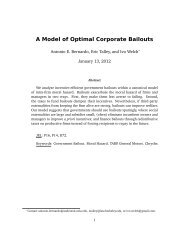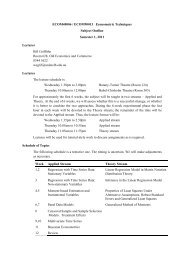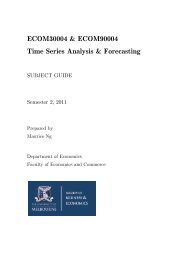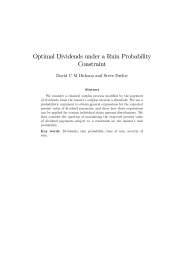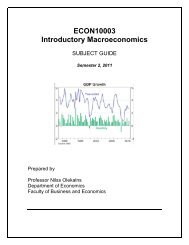Bayesian Inference in the Seemingly Unrelated Regressions Model
Bayesian Inference in the Seemingly Unrelated Regressions Model
Bayesian Inference in the Seemingly Unrelated Regressions Model
Create successful ePaper yourself
Turn your PDF publications into a flip-book with our unique Google optimized e-Paper software.
15<br />
Although <strong>the</strong> above remarks on convergence and numerical standard errors<br />
were made <strong>in</strong> <strong>the</strong> context of <strong>the</strong> Gibbs sampler for β and Σ , <strong>the</strong>y also apply to o<strong>the</strong>r<br />
MCMC algorithms <strong>in</strong>clud<strong>in</strong>g <strong>the</strong> Gibbs sampler for β and <strong>the</strong> Metropolis Hast<strong>in</strong>gs<br />
algorithm described below.<br />
F. Gibbs Sampl<strong>in</strong>g with β<br />
If <strong>the</strong> number of equations is large, mak<strong>in</strong>g Σ of high dimension, <strong>the</strong>n it may be<br />
preferable to use a Gibbs sampler based on <strong>the</strong> conditional posterior pdfs for <strong>the</strong> β i<br />
from each equation. Note, however, that this alternative is not feasible if crossequation<br />
restrictions on <strong>the</strong> β i , as discussed <strong>in</strong> Sections V and VII, are present.<br />
To proceed with this Gibbs sampler, we beg<strong>in</strong> with start<strong>in</strong>g values for all<br />
coefficients except <strong>the</strong> first, say<br />
(0) (0) (0)<br />
2 3<br />
( β , β ,…, β M ) and <strong>the</strong>n sample iteratively us<strong>in</strong>g<br />
<strong>the</strong> follow<strong>in</strong>g steps for <strong>the</strong> $ -th draw:<br />
1. Draw<br />
2. Draw<br />
( )<br />
β $ 1 from ( ( $ − 1) ( $ −<br />
f β 1)<br />
1| β2<br />
, , βM<br />
)<br />
… .<br />
( )<br />
β $ 2 from ( ( $ ) ( $ − 1) ( $ −<br />
f β 1)<br />
2 | β1 , β3<br />
, , βM<br />
)<br />
… .<br />
!<br />
i. Draw<br />
( )<br />
β $ i from ( ( $ ) ( $ ) ( $ − 1) ( $ −<br />
f β | 1)<br />
i β1 , , βi− 1, βi+<br />
1 , , βM<br />
)<br />
… … .<br />
!<br />
M. Draw<br />
( )<br />
β $ M from ( ( $ ) ( $<br />
f β | )<br />
M β1 , , βM−1)<br />
… .<br />
The conditional posterior pdfs are multivariate t-distributions from which we can<br />
readily draw values (see <strong>the</strong> Appendix). Ord<strong>in</strong>ary least squares estimates are adequate<br />
for start<strong>in</strong>g values.



